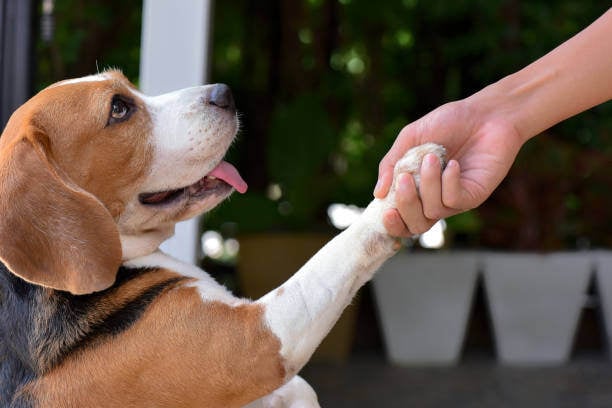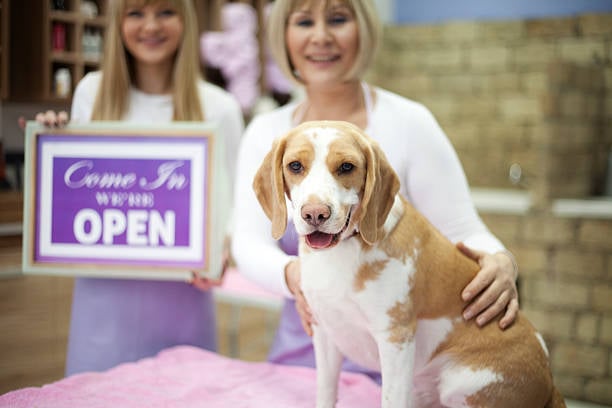In a 2025 study that included over 43,000 canine subjects, 99% of U.S. dogs were reported to have moderate to severe behavior issues. While most of these dogs don’t have a lengthy list of problems, they may exhibit barking, jumping, or other problematic behaviors.
Some of these behaviors could be caused by other issues, like anxiety, that require a veterinary diagnosis and treatment. However, proper training can correct many of these problems. That’s where dog training businesses like yours come in.
As a professional dog trainer, you have both the time and expertise needed to train pet parents’ dogs in the ways that best meet their needs and lifestyles. Whether you have a playful puppy that needs to learn the basics or a seasoned canine companion that’s ready for advanced skills in your care, adding a few new tricks to their repertoire can be both entertaining and practical. Explore these dog training basics and our top fun and useful tricks.
3 FAQs About Dog Training Tricks
1. Why is dog training important?
As a dog training professional, you understand the key role that effective training plays in:

- Ensuring the safety of the dog and others with commands like “come” or “stay” that can prevent incidents.
- Strengthening the bond between dogs and pet parents by establishing a shared language and sense of teamwork.
- Providing mental stimulation, which prevents boredom, anxiety, and destructive behaviors.
- Improving dogs’ manners around people and other animals.
- Preventing problematic behaviors like barking or jumping in young dogs by addressing them before they become ingrained habits.
It’s important to communicate these benefits to your current and potential clients so they understand the value of training. Current clients will be more likely to do their training “homework” to improve outcomes and continue purchasing your services. Potential customers will see the positive impacts that dog training services can have on their lifestyle, their pet’s quality of life, and their relationship with their dog.
2. What do you need to get started with trick training?
As a trainer, you likely already have some favorite tools and strategies. But just as old dogs can learn new tricks, experienced trainers can learn new methods or helpful products that make teaching easier.
To get started, you’ll need:
- High-value treats (i.e., extra tasty ones that will keep dogs highly motivated)
- A clicker tool
- A treat pouch
- A target stick
- Training props, as needed for specific tricks (e.g., cones to weave through)
- Training mat or bed (for teaching “go to [place]” tricks)
Additionally, you may put together a similar, basic list like this for pet parents who are eager to further their dog’s training at home.
3. What dog training tricks should you prioritize?
There is no single, universally true answer here—it depends on the dog. You might prioritize different tricks based on:
- The dog’s physical and mental traits (e.g., age, breed, temperament)
- The pet parent’s goals and lifestyle
- Existing problem behaviors
- Missing foundational skills
For example, a rescue struggling with anxiety and reactivity may just need to focus on foundational skills at first. On the other hand, a high-energy, working breed like a Labrador Retriever needs more enriching activities to scratch their innate itch to retrieve.
Carefully consider these factors, as well as any specific requests or input from pet parents, when building out each dog training plan. Assemble a quick profile with basic information about the dog, and then outline specific goals, target commands, training methods, a schedule, and required supplies.
Top Dog Training Tricks for Every Occasion
We’ve sorted the following dog training tricks into distinct categories, each with its own purpose:
- Foundational Manners & Safety: Basic tricks like “stay” and “drop it” help prevent accidents and establish essential rules for a well-behaved companion.
- Fun & Entertaining Tricks: Not only are these tricks fun to perform for friends and family, but they also provide positive mental stimulation for the dog.
- Coordination & Body Awareness: These tricks help the dog become more aware of its body and improve balance, which can boost confidence and prevent injuries.
- Advanced Skills: More advanced tricks truly put dogs’ intelligence to the test with complicated, multi-step tasks, such as “clean up your toys.” You’ll need to work your way up to these tricks, as they require dogs to understand simpler skills first.
Foundational Manners & Safety

1. Stay
Teaching your dog to stay is a fundamental command that helps with safety and discipline. This skill helps with behaving in public spaces, competing in canine sports, and preventing them from escaping through open doors.
How to Teach This Trick
- Start with the dog in a sitting or lying down position.
- Hold your hand out in front of them, palm facing out, and say "stay."
- Take a step back, and if your dog stays, reward them with a treat.
- Gradually increase the distance and duration before rewarding them, always reinforcing the "stay" command.
2. Drop It
Teaching your dog to drop items on command can be incredibly useful, especially if they grab something they shouldn’t have. Start with low-value items (like toys or random household objects) and progress to higher-value items (food, chews, etc.) to build a bulletproof "drop it."
How to Teach This Trick
- Offer the dog a toy or item to hold in their mouth.
- Hold a treat near their nose and say, "Drop it."
- When they release the item, reward them with the treat.
- Practice this regularly to reinforce the command, slowly working up to the highest-value items.
3. Wait
Wait is similar to “stay” but can be used in a wider variety of contexts. Additionally, it typically has two components: the “wait” command and the “release” command, which frees dogs to take some kind of action. This is commonly used during feeding times, fetching or retrieving training, and for car rides.
How to Teach This Trick
- With the dog ready in a sitting or lying position, hold up your hand like a stop sign and say, “Wait.”
- Place a treat on the floor in front of them.
- Before they can take the treat, cover or remove it.
- If they pause, affirm them verbally (e.g., “Good!” or “Okay!”) and let them have the treat. Gradually increase the time and distance.
4. Quiet
This trick teaches dogs to stop barking on command. This is a practical trick for reactive dogs and/or pet parents who live in apartment buildings and don’t want to disturb their neighbors.
How to Teach This Trick
- Identify triggers that cause the dog to bark (e.g., a doorbell chime or knocking sound).
- As soon as the dog barks, say “Quiet” and present a high-value treat.
- When the dog stops barking to smell and eat the treat, praise them verbally and with pets.
- Work to gradually increase the duration they must be quiet in order to earn the treat.
Fun & Entertaining Tricks

5. Shake Hands
Teaching your dog to shake hands is a classic, crowd-pleasing trick. It’s simple to teach and is a great way for your dog to greet new people. Plus, it’s an easy way to reinforce good behavior with a fun reward.
How to Teach This Trick
- Start with the dog in a sitting position.
- Hold a treat in your hand and let the dog sniff it.
- As they lift their paw to reach for the treat, gently take their paw in your hand and say, "Shake."
- Reward them with the treat and praise. Repeat until they associate the command with the action.
6. Spin
Getting your dog to spin in a circle on command is a playful trick that can also help them release some energy. It’s a great way to add some fun to your training sessions, and it makes a good warm-up before moving on to more complex tasks.
How to Teach This Trick
- Hold a treat close to your dog’s nose.
- Slowly move your hand in a circular motion parallel to the ground, guiding your dog to follow it with their head and body.
- As your dog completes the circle, say "spin" and reward them with the treat.
- Practice until they can spin without needing to be guided.
7. Roll Over
Rolling over is another classic trick that dogs love to learn. It’s a bit more complex than the basics, but with patience and consistency, your dog will master it. This trick can also be a stepping stone to teaching more advanced behaviors.
How to Teach This Trick
- Start with the dog lying down.
- Hold a treat close to their nose and move it slowly toward their shoulder, encouraging them to roll onto their side.
- Continue moving the treat in a circular motion to guide them to roll all the way over.
- Say "roll over" as they complete the motion, then reward with the treat.
8. Play Dead
The "play dead" trick is always a hit, especially when you add in the dramatic flair of saying, "Bang!" Teaching your dog to lie down and stay still is both entertaining and a valuable exercise in impulse control.
How to Teach This Trick
- Start with the dog in a lying-down position.
- Hold a treat near their nose and slowly move it to the side, encouraging them to roll onto their side.
- As they roll over, say "bang" or "play dead."
- Reward them with a treat and praise. Repeat until they can do it on command.
9. Bow
Teaching your dog to bow (i.e., have their front legs down and rear end up) is both cute and a good stretch for them. This trick is often used in agility training and can be a fun way to finish a performance.
How to Teach This Trick
- Start with the dog standing.
- Hold a treat near the ground between their front paws.
- As they lower their front half to reach the treat, say "bow."
- Reward once they hold the bow position for a moment. Practice until they can bow on command.
10. Crawl
For this trick, the dog lowers all the way to the ground and moves forward on its belly without fully standing up. This can help build confidence, strengthen the dog’s core muscles, and could even come in handy in tight spaces.
How to Teach This Trick
- Start with the dog in a sitting or lying position.
- Hold a treat in front of their nose, and drag it slowly across the floor.
- When the dog moves forward to follow the treat (while remaining low to the ground), praise and reward them.
- Keep going, working to extend the distance they crawl forward.
11. Cover Your Nose (Shy)
This trick aims to make the dog appear shy or bashful by covering its nose with its paw on cue. It’s an adorable trick that’s perfect for taking cute photos or entertaining friends and family.
How to Teach This Trick
- Gently stick a piece of tape or a sticky note to the top of the dog’s nose (ensure the adhesive isn’t strong enough to tug at their fur or skin).
- The dog should naturally lift their paw to remove it—reward them when their paw touches their nose.
- Repeat this until the dog anticipates the reward and repeats the motion with the tape or sticky note.
- Add in a verbal cue, like “shy” or “cover your nose.”
12. Wave
Teach the dog to “wave” hello or goodbye by holding up their paw on command. Not only is this a cute trick others will enjoy, but it trains the dog to greet people in a polite way rather than jumping or barking.
How to Teach This Trick
- Start by having the dog sit, and hold a treat in a closed fist in front of them.
- Observe until the dog paws at your hand.
- When the dog lifts their paw, say “yes” and reward them with your free hand.
- Once they are reliably lifting their paw, add the verbal “wave” cue.
Coordination & Body Awareness

13. Paws Up
Teach dogs to put their two front paws up on an elevated object, such as a chair or your arm. While this can be a great photo pose, it also has practical uses. It reinforces the dog’s sense of balance and can prepare them for positioning during veterinary exams and grooming appointments.
How to Teach This Trick
- Choose a sturdy, low object for the dog to prop its front paws on (e.g., a heavy box).
- Lure the dog toward the object with a treat or toy, and hold it over the object.
- Raise the treat high enough to encourage the dog to step up on the object, and reward them when they do.
- Repeat the trick, adding the “paws up” verbal cue.
14. Back Up
Train the dog to walk backward in a straight line. This is a more practical skill designed to help a dog effectively navigate tighter spaces without needing to turn around.
How to Teach This Trick
- Stand in front of the dog in a narrow space, such as a hallway.
- Say “back up” and take a step toward them.
- When the dog instinctively takes a step backward, reward them with a treat.
- Repeat this process, gradually extending the distance the dog backs up.
15. Pivot
For this trick, the dog learns to pivot while keeping its front paws on a small platform and turning its rear end around in a circle. This is considered a foundational skill for canine sports as it teaches rear-end awareness. However, the pivot move can also come in handy at the vet and groomer.
How to Teach This Trick
- Place a small, flat object on the floor (e.g., a book), and encourage the dog to place their front paws on it. This step may take some time and repetition.
- Once they’ve mastered keeping their paws on the book, hold a treat near their nose and lure their head toward one of their shoulders.
- As their head turns, their back feet should step to the side—this is the moment to reward them.
- Continue rewarding these small side steps, building up until the dog can turn in a full circle.
Advanced Skills

16. Touch
Touch is also referred to as “targeting.” For this skill, you have the dog touch its nose to your hand or the end of a target stick. Mastering targeting is a crucial skill for moving on to more complex tricks like closing doors or switching on lights.
How to Teach This Trick
- Hold out your hand or target stick to the dog.
- When the dog sniffs your hand or stick, reward them with your free hand.
- Repeat the process, adding the cue “touch” before they make contact.
- Challenge them by presenting your hand or the stick at different heights and distances.
17. Fetch Specific Items
Teaching dogs to fetch specific items, like their leash or a favorite toy, can be incredibly useful. It’s also a fun way to challenge their intelligence and build their confidence.
How to Teach This Trick
- Begin by teaching the dog the names of different objects, like “ball” or “leash.”
- Hold up the item, say its name, and encourage your dog to touch it with their nose.
- Gradually build up to asking your dog to fetch the item from a short distance.
- Reward them each time they bring back the correct item.
18. Clean Up Toys
This command challenges dogs to pick up their toys and return them to a designated place, like a bin or basket. If dogs are able to complete the trick, they can help pet parents keep the house tidy and show off an impressive skill.
How to Teach This Trick
- Start with one toy and an empty toy box. Play with the toy for a few minutes, and cue the dog to “hold” it.
- With the dog holding the toy, lure them to the box and say, “Drop it.” If they follow directions, give them a high-value reward and lots of praise.
- Repeat until they understand the game, adding the cue “clean up” when they pick up the toy.
- Gradually add more toys and distance from the toy box, and only reward them when they successfully place a toy in the box.
19. Open & Close Doors
Want a trick that’s both impressive and practical? Teaching dogs to open and close doors can be a helpful skill, especially if pet parents have their hands full. Start with a light door, like a cupboard, and gradually move to heavier doors as the dog gains confidence.
How to Teach This Trick
- Attach a small towel to a door handle or cupboard door at the dog’s height.
- Encourage the dog to tug on the towel by using a treat as a lure.
- Once they pull the door open, say "open" and reward them.
- To teach closing, hold a treat near the door and guide the dog’s nose toward it, encouraging them to push the door shut. Use the command "close" and reward them.
20. Sit Pretty
Teaching dogs to "sit pretty" (sitting up on their hind legs) is an adorable trick that strengthens their core muscles. Keep in mind that teaching this command to dogs with shorter legs, like corgis or dachshunds, is harder.
How to Teach This Trick
- Start with the dog sitting.
- Hold a treat just above their nose and encourage them to lift their front paws off the ground to reach it.
- As they balance on their hind legs, say "sit pretty" and reward them with the treat.
- Practice balancing for longer periods before rewarding.
Wrapping Up
Teaching dogs new tricks is fun, challenges their intelligence, and makes life more enjoyable for dogs and pet parents. From practical skills like learning to stay or drop items to charming tricks like sitting pretty, each adds a new dimension to the dog-human relationship. So, grab some treats, start practicing, and watch your dog impress everyone with their new talents.
If you run a dog training business, book a demo of Gingr’s dedicated pet business software to see how we can streamline your operations, from booking to billing. Additionally, check out our additional resources to optimize your business:
- 5 Expert Digital Marketing Tips for Pet Professionals. Spread the word about your dog training business with these expert digital marketing tips designed for the pet-care industry.
- 12 Must-Try Dog Daycare Ideas for Happy, Healthy Pups. If your business offers dog daycare or boarding services, you must try these enriching activities.
- Streamline Bookings With Pet Scheduling Software. The right scheduling tools can help you manage bookings efficiently and train more happy dogs.
Subscribe to the Gingr Blog







